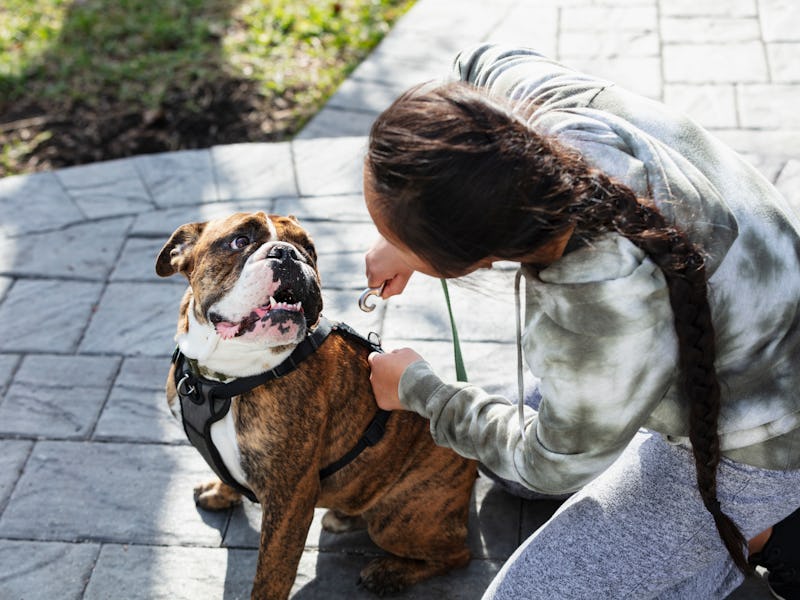What Could Happen If You Don’t Clean Up Your Dog’s Poop? The Answer Is Terrifying
Dog feces may contain microorganisms that cause illness in humans, such as Salmonella, E. coli, Giardia, and internal parasites.

What’s that smell? Is that what you think it is? You check your shoes, and sure enough, one is adorned with a sticky, foul-smelling patty of fresh wrongness. You have stepped into a landmine of the canine variety.
We’ve all been there, and we all know footpaths, nature strips, parks, playing fields, and front lawns are not good places for dog poop to sit.
Yet, our streets and parks continue to be littered with dog poop. And with the pandemic driving a surge in dog ownership, anecdotal reports suggest the dog poop problem has grown only worse in recent years.
Beyond the obvious unsightliness and the likelihood of making unwanted contact with dog poop, there are some other important reasons to pick up after dogs.
Here’s what you need to know and what the science says about common efforts to deter dogs from pooping in your yard.
Dog poop is linked to illness, pollution, and antibiotic resistance
Dog feces may contain microorganisms that cause illness in humans, such as Salmonella, E. coli, Giardia, and internal parasites.
Dog poop can also be a potential reservoir for antibiotic-resistant bacteria, meaning humans could develop bacterial infections that are difficult to treat through contact with dog feces.
A recent Sydney study also identified dog feces washed into stormwater as a significant contributor to water pollution.
This topic, in spite of its relevance and impact, has received little attention from scientists. Thankfully, however, we have a few brave souls who can say they have studied dog crap for the betterment of humanity.
This research has revealed some patterns in where dog feces is found in public.
Where is the dog poop problem more common?
Dog fouling is significantly more common in parks where dogs are allowed off-leash and areas close to car parks.
The way dog walkers have traditionally used an area may also be an important factor, with one UK study noting:
Availability of bins, path morphology, visibility, and path location are key factors in determining the occurrence of dog feces.
The same study noted that while most dog walkers do the right thing, some are too “proud to pick up,” while others make contextual judgments about where and when it could be permissible to leave dog waste. Yet others are “disengaged” dog walkers, who “will not pick up even if they are aware of the health and environmental consequences.”
Other research has suggested targeting keeping dogs on leashes between car parks and off-leash areas and providing waste disposal stations on popular dog-walking routes.
This doesn’t help if you have a neighbor who lets their dog out to relieve themselves on the nature strip (or your yard) or people who walk their dogs without carrying waste disposal bags.
And we all love the ones who bag the poop but leave the bag tied to a fence or by a gate.
What about the old water-bottles-on-the-grass trick?
Dog owners who don’t pick up after their dogs can be fined, but it can be hard to catch them in the act, and reporting a neighbor to authorities can often lead to ongoing hostility.
Bottles of water on the grass are a time-honored strategy to deter dogs, but there is no evidence this is effective and no clear reason why it would be.
Dogs sometimes like to circle and find just the right spot to go, so they may prefer an area that has fewer obstacles to negotiate. Perhaps a yard bristling with lawn ornaments would enjoy some protection. (Interestingly, science suggests dogs may circle around like this to align their body to face north.)
There are commercially available dog deterrents, but little evidence they are effective and under what conditions.
Some believe any strong scent may deter an animal with a very strong sense of smell from lingering long enough to take a dump. But scent travels, so heavy and repeated applications would likely be needed (and this strategy could have unintended side effects on native urban ecosystems).
Educating dog walkers is key
Aside from providing bags and a bin and enforcing leash laws, particularly around carparks close to off-leash areas, research suggests education does help.
Messages emphasizing that good neighbors and members of the community diligently pick up after their dogs may be most effective, as people are responsive to social messages.
If you have tried to appeal to your neighbor’s sense of community to no avail, and you’re not keen on a front yard bristling with garden gnomes and flamingos or drenched in possible dog-deterring chemicals, you could try providing bags and a sign promising surveillance.
For all the dog owners out there that do pick up after their dogs, your community thanks you.
The best way to dispose of dog feces is in the bin. Composting requires high temperatures to neutralize the nasties in dog poop, and home composts are unlikely to get hot enough. And burying it simply allows these microorganisms to build up in the soil.
This article was originally published on The Conversation by Melissa Starling at the University of Sydney. Read the original article here.